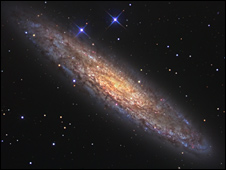 |
Space dust makes this distant galaxy appear half as bright

|
The universe is twice as bright than previously thought, astronomers claim.
Researcher from St Andrews University said dust was obscuring about half the light that the universe generates.
They said that astronomers have known for some time that the universe
contains small grains of dust but not how much light those particles
obscure.
Scientists had been baffled because the dust soaks up light and glows,
making it appear that a galaxy is emitting more energy that it actually
is.
Dr Simon Driver, school of physics and astronomy, said: "For nearly two
decades we've argued about whether the light that we see from distant
galaxies tells the whole story or not. It doesn't.
"In fact only half the energy produced by stars actually reaches our telescopes directly, the rest is blocked by dust grains."
Glowing dust
Researchers said the dust absorbs starlight and re-emits it, making it glow.
Scientists have known that existing models were flawed because the
energy output from glowing dust appeared to be greater than the total
energy produced by the stars.
Dr Driver said: "You can't get more energy out than you put in so we
knew something was very wrong. Even so, the scale of the dust problem
has come as a shock - it appears galaxies are generating twice as much
starlight as previously thought."
 |
 We can now calculate precisely the fraction of starlight blocked by the dust
We can now calculate precisely the fraction of starlight blocked by the dust

|
Astronomers calculated the fraction of starlight blocked by the dust.
The key test that the new model passed was whether the energy of the
absorbed starlight equated to that detected from the glowing dust.
Researcher Dr Christina Popescu said: "The equation balanced perfectly
and for the first time we have a total understanding of the energy
output of the universe over a monumental wavelength range.
"With the new calibrated model in hand we can now calculate precisely the fraction of starlight blocked by the dust."
The Universe is currently generating energy, via nuclear fusion in the
cores of stars, at a rate of five quadrillion watts per cubic light year
- about 300 times the average energy consumption of the Earth's
population.
After carefully measuring the brightness of thousands of disc-shaped
galaxies with different orientations, the astronomers matched their
observations to computer models of dusty galaxies.
From this they were able to calibrate the models and, for the first
time, determine how much light was obscured when a galaxy has a face-on
orientation.
While modern instruments allow astronomers to see further into space,
they cannot eliminate the obscuring effect from these tiny dust grains.
The findings have been published in Astrophysical Journal.
|


![]() © 2011
© 2011



Bookmark with:
What are these?